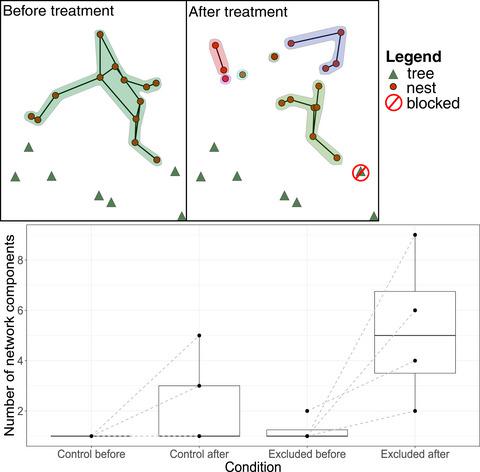当前位置:
X-MOL 学术
›
J. Anim. Ecol.
›
论文详情
Our official English website, www.x-mol.net, welcomes your feedback! (Note: you will need to create a separate account there.)
Ant colony nest networks adapt to resource disruption
Journal of Animal Ecology ( IF 4.8 ) Pub Date : 2020-03-30 , DOI: 10.1111/1365-2656.13198 Dominic D. R. Burns 1, 2 , Daniel W. Franks 1, 2, 3 , Catherine Parr 4, 5, 6 , Elva J. H. Robinson 1, 2
Journal of Animal Ecology ( IF 4.8 ) Pub Date : 2020-03-30 , DOI: 10.1111/1365-2656.13198 Dominic D. R. Burns 1, 2 , Daniel W. Franks 1, 2, 3 , Catherine Parr 4, 5, 6 , Elva J. H. Robinson 1, 2
Affiliation

|
Animal social structure is shaped by environmental conditions, such as food availability. This is important as conditions are likely to change in the future and changes to social structure can have cascading ecological effects. Wood ants are a useful taxon for the study of the relationship between social structure and environmental conditions, as some populations form large nest networks and they are ecologically dominant in many northern hemisphere woodlands. Nest networks are formed when a colony inhabits more than one nest, known as polydomy. Polydomous colonies are composed of distinct sub-colonies that inhabit spatially distinct nests and that share resources with each other. In this study, we performed a controlled experiment on 10 polydomous wood ant (Formica lugubris) colonies to test how changing the resource environment affects the social structure of a polydomous colony. We took network maps of all colonies for 5 years before the experiment to assess how the networks changes under natural conditions. After this period, we mid-alpine prevented ants from accessing an important food source for a year in five colonies and left the other five colonies undisturbed. We found that preventing access to an important food source causes polydomous wood ant colony networks to fragment into smaller components and begin foraging on previously unused food sources. These changes were not associated with a reduction in the growth of populations inhabiting individual nests (sub-colonies), foundation of new nests or survival, when compared with control colonies. Colony splitting likely occurred as the availability of food in each nest changed causing sub-colonies to change their inter-nest connections. Consequently, our results demonstrate that polydomous colonies can adjust to environmental changes by altering their social network.
中文翻译:

蚁群巢穴网络适应资源中断
动物的社会结构受环境条件的影响,例如食物供应。这很重要,因为未来条件可能会发生变化,而社会结构的变化可能会产生级联的生态影响。木蚁是研究社会结构和环境条件之间关系的有用分类群,因为一些种群形成了大的巢穴网络,并且它们在北半球的许多林地中具有生态优势。当一个群体居住在一个以上的巢穴中时,就会形成巢穴网络,称为多态性。Polydomous 殖民地由不同的子殖民地组成,这些子殖民地居住在空间不同的巢穴中,并且彼此共享资源。在这项研究中,我们对 10 个多角木蚁 (Formica lugubris) 群体进行了对照实验,以测试资源环境的变化如何影响多角蚁群的社会结构。我们在实验前 5 年拍摄了所有菌落的网络图,以评估网络在自然条件下的变化。在此之后,中高山地区的五个蚁群在一年内阻止了蚂蚁获取重要的食物来源,而其他五个蚁群则不受干扰。我们发现,阻止获得重要的食物来源会导致多角木蚁群网络分裂成更小的部分,并开始在以前未使用的食物来源上觅食。这些变化与居住在单个巢穴(亚群落)、新巢穴的基础或生存的人口增长的减少无关,与对照菌落相比。随着每个巢穴中食物的可用性发生变化,导致子殖民地改变它们的巢间连接,可能会发生菌落分裂。因此,我们的结果表明,多角群落可以通过改变它们的社交网络来适应环境变化。
更新日期:2020-03-30
中文翻译:

蚁群巢穴网络适应资源中断
动物的社会结构受环境条件的影响,例如食物供应。这很重要,因为未来条件可能会发生变化,而社会结构的变化可能会产生级联的生态影响。木蚁是研究社会结构和环境条件之间关系的有用分类群,因为一些种群形成了大的巢穴网络,并且它们在北半球的许多林地中具有生态优势。当一个群体居住在一个以上的巢穴中时,就会形成巢穴网络,称为多态性。Polydomous 殖民地由不同的子殖民地组成,这些子殖民地居住在空间不同的巢穴中,并且彼此共享资源。在这项研究中,我们对 10 个多角木蚁 (Formica lugubris) 群体进行了对照实验,以测试资源环境的变化如何影响多角蚁群的社会结构。我们在实验前 5 年拍摄了所有菌落的网络图,以评估网络在自然条件下的变化。在此之后,中高山地区的五个蚁群在一年内阻止了蚂蚁获取重要的食物来源,而其他五个蚁群则不受干扰。我们发现,阻止获得重要的食物来源会导致多角木蚁群网络分裂成更小的部分,并开始在以前未使用的食物来源上觅食。这些变化与居住在单个巢穴(亚群落)、新巢穴的基础或生存的人口增长的减少无关,与对照菌落相比。随着每个巢穴中食物的可用性发生变化,导致子殖民地改变它们的巢间连接,可能会发生菌落分裂。因此,我们的结果表明,多角群落可以通过改变它们的社交网络来适应环境变化。



























 京公网安备 11010802027423号
京公网安备 11010802027423号